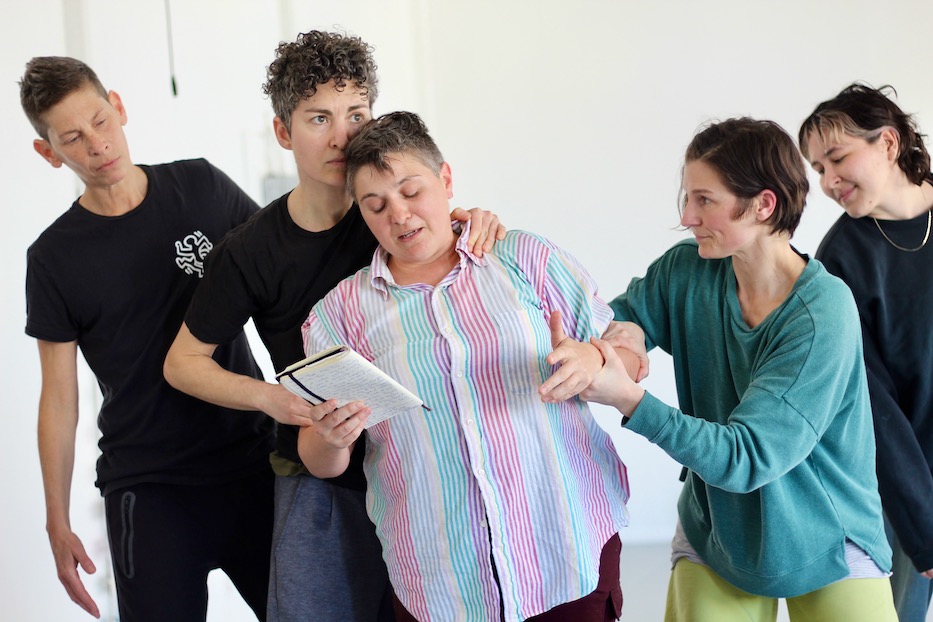
Dance | Elm City Dance Collective | LGBTQ | Arts & Culture | New Haven Pride Center
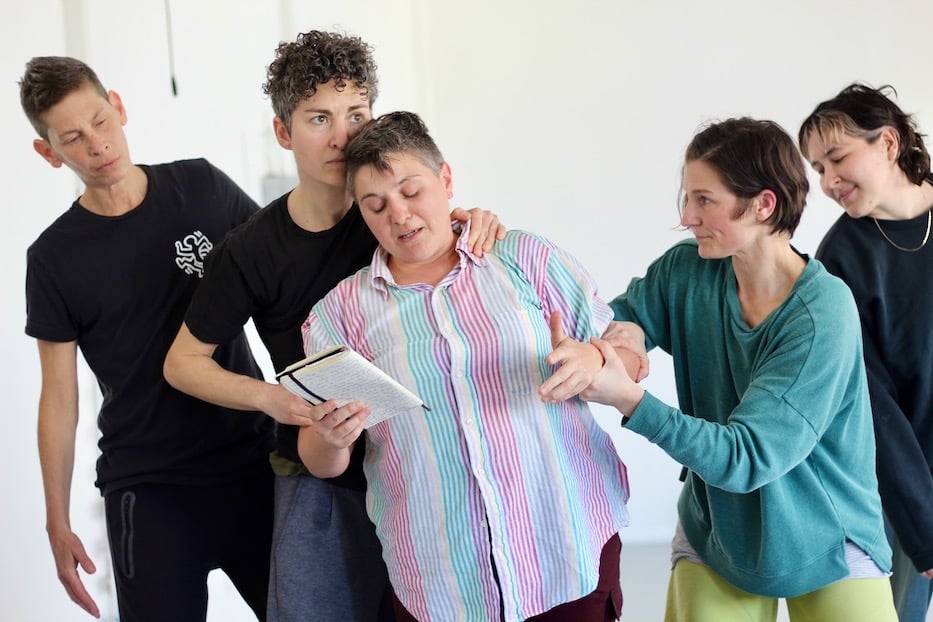
Nancy Weisman, Lindsey Bauer, Nikki Lee, Kellie Ann Lynch, and Lillie Steinhauser. Lucy Gellman Photos.
Nikki Lee collapsed back, their head and shoulders resting on the warmth of Lindsey Bauer’s chest. Their feet glided across the space, toes treading the sprung floor. Fellow dancers held their arms; a wrist flopped back and found a space to rest. A notebook rested between the fingers of their left hand.
“I wonder what it’s like to know exactly who I am—and stop,” they said. The group struck a freeze frame. “What I want and what I don’t want—move me,” the group began to shift, lifting Lee off the floor so that they were suddenly floating in midair. “If I had that down, how would I spend my time?” The question hung in the air as Lee continued to read. “If not, I might figure all that out. Stop.”
It marked the evolution of “Trans Body,” a years-long collaboration between Elm City Dance Collective (ECDC) and the New Haven Pride Center that came to Erector Square at 319 Peck St. Sunday afternoon for an in-process viewing and short talkback. Four years in, it took place as more of an open studio than a fully finished dance piece, welcoming more nonbinary dancers into the group than in years past.
A second iteration of the dance is normally held in mid November, in honor of Transgender Awareness Week. Read more about previous performances, including online during the first years of the Covid-19 pandemic, here, here, and here. This year, the project received support from the Mayor’s Neighborhood Cultural Vitality Grant Program.
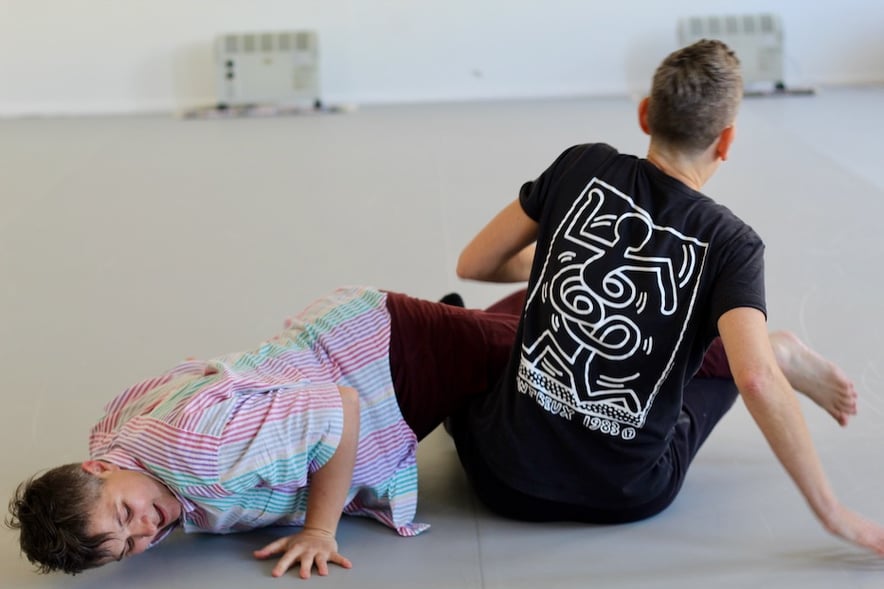
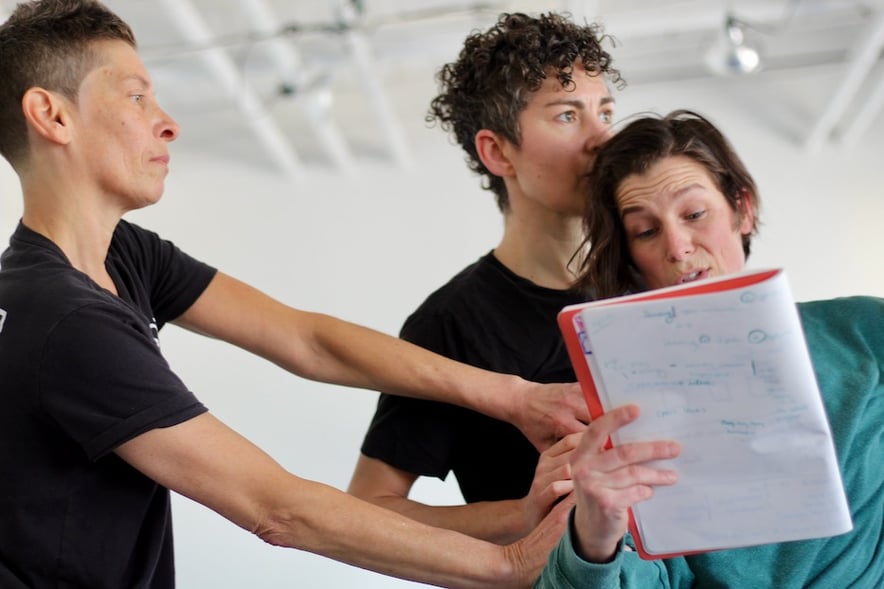
“You show up as you show up, and that's it,” said ECDC Co-Founder Kellie Ann Lynch, who is a cisgender ally. “We got you. We don't need to perform any other version of ourselves. We are who we are in this space with each other, and that's what this project is about. It's about belonging, and holding each other, and seeing each other.”
Now in its fourth year and sixth iteration, Trans Body has unfolded as a highly collaborative process, with some participants who were not able to make Sunday’s open studio. When rehearsals began earlier this month, dancers began with themes they wanted to bring in, from a sense of place to writing prompts rooted in identity and awareness.
One dancer, for instance, suggested building a song, in a mashup of speech and movement that has long been part of the project. Another threw out the phrase “Sculpture Garden,” which opened a discussion around space and place. In a notebook entry from March 15, Lynch has organized a creative brain dump into color-coded lists, boxes and flow charts, the words bursting into pink and green across two pages.
They create a window into a process all about mutual trust. In one space, a neat pink scrawl simply reads Get your ass in the bosom of unconditional love. In another, the words Sculpture Garden tower over other text in purple. Among prompts that they brought back from previous years, one of the most powerful focused on writing responses to the phrases “I Notice,” “I Wonder,” and “It Reminds Me.”
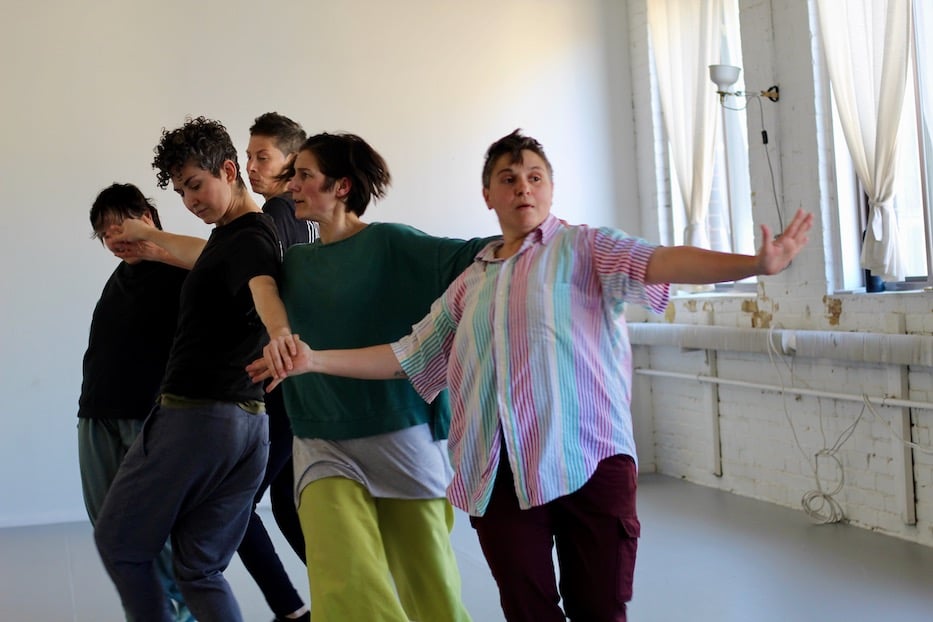
Sunday, attendees got a rare chance to see the result in real time, much of it still in draft and improvisational form. Just a little past 1:30 in the afternoon, five dancers took their place in the studio, warming up as a small audience trickled in. As light streamed through the second-floor windows, hands rested gingerly on shoulders. Limbs stretched out in all directions. Backs bent toward the floor, spines elongating.
Placing a series of prompts on the floor, Lynch invited attendees to participate, watching as dancers spread out across the studio. For every prompt, she explained, two or three dancers would come into the center of the floor, and respond with movement to what they’d just heard. As she spoke, some of the dancers pretzeled themselves against each other, in even a warm up that centered touch and trust.
“What if it’s a statement?” asked one attendee, reading over the words that they had just picked up from the floor. A piece of paper fluttered between their thumb and forefinger. Lynch and Bauer exchanged a quick glance and tiny shrug, as if to say it wasn’t a problem. The attendee smiled, taking a beat before their voice rang across the space, clear as a bell.
“The feeling is mutual!” they announced.
Without ever exchanging words, Lee and dancer Nancy Weisman moved toward the center of the floor, the sound of their footfalls audible in the space. From the right side of the room, Lynch joined them, one arm entertwined with Lee’s. They rushed forward, threading their bodies together, pulling apart, and coming together again. From a standing formation, they sank into the floor, Lee balancing on Lynch’s back. To their left, Weisman leaned on one arm to support the two. 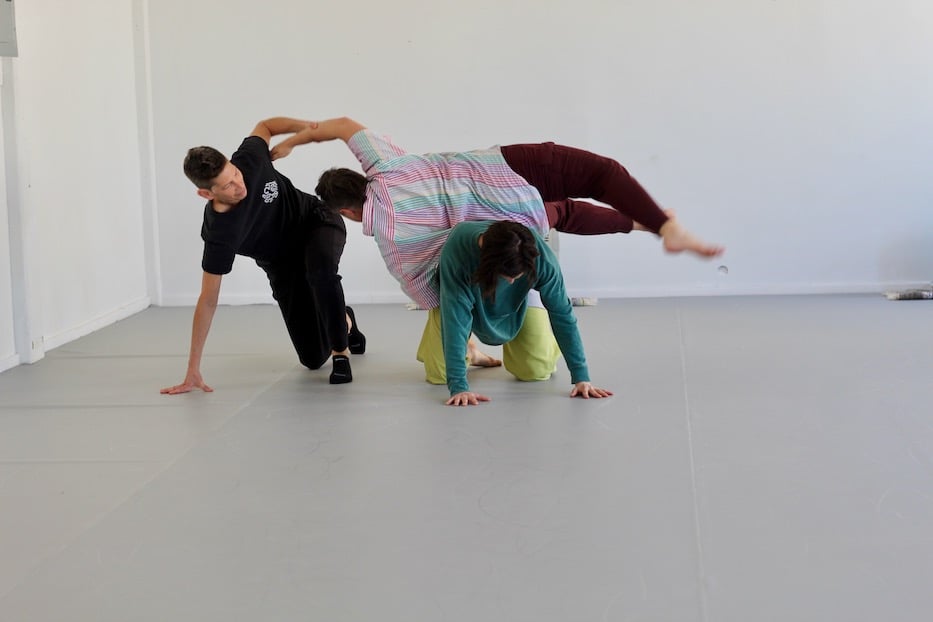
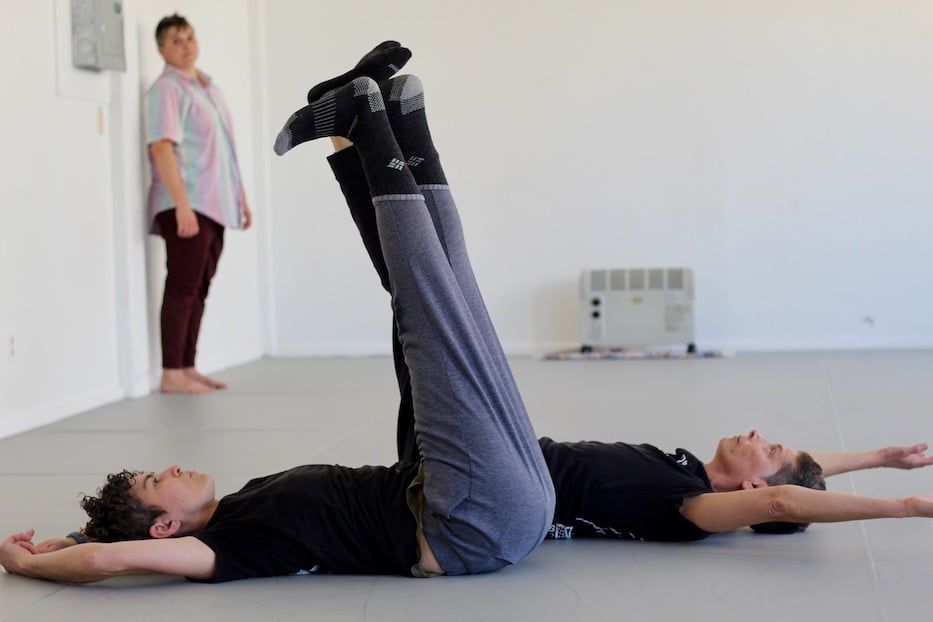 At the end of two, maybe three minutes, they retreated to the sides of the room, and listened for the next prompt. Applause filled the space, music still audible beneath it. “Is that still a part of me?” ventured Marannie Rawls-Philippe.
At the end of two, maybe three minutes, they retreated to the sides of the room, and listened for the next prompt. Applause filled the space, music still audible beneath it. “Is that still a part of me?” ventured Marannie Rawls-Philippe.
This time, it was Bauer who made the first steps onto the floor, facing the back wall before she turned, and approached attendees. As she moved forward, Lee entered, followed by dancer Lillie Steinhauser. Feeling out the space beside Lee, Steinhauser bent forward, fingers extended to the floor as their shoulders relaxed. Lee lowered their body to the floor, pressing one ear to the ground. It was as if, for a moment, they were listening to see if the building was breathing.
Wah-ah-wah-ah-wah! A chorus of voices sang over a speaker set atop a sunlit windowsill. Every so often, Rawls-Philippe and Bauer’s two young sons let out ringing, buoyant peals of laughter that instantly became part of the soundtrack.
They were just getting started, it seemed. To the question “Did you do that thing yet?” Lee began with their body gliding through the space, arms outstretched, as if they were guiding a kite through the wide, open sky. When Weisman joined in, the two became opposite sides of a mirror, a life and a shadow life in real time. At one point, they half-jogged forward, and it felt as if time was splitting, then gelling back together. Where words weren’t necessary, laughter still crept in.
To the question “Do you have a dog pet?” Bauer turned her body into a pogo stick, gathering height as she jumped behind Weisman, then came back down squarely on two feet. Both she and Weisman let themselves lean into the soft, silly edges of the question, drawing up their hands and wrists as if they were suddenly paws, then letting their limbs go in a way that seemed not quite human, but not not human either.
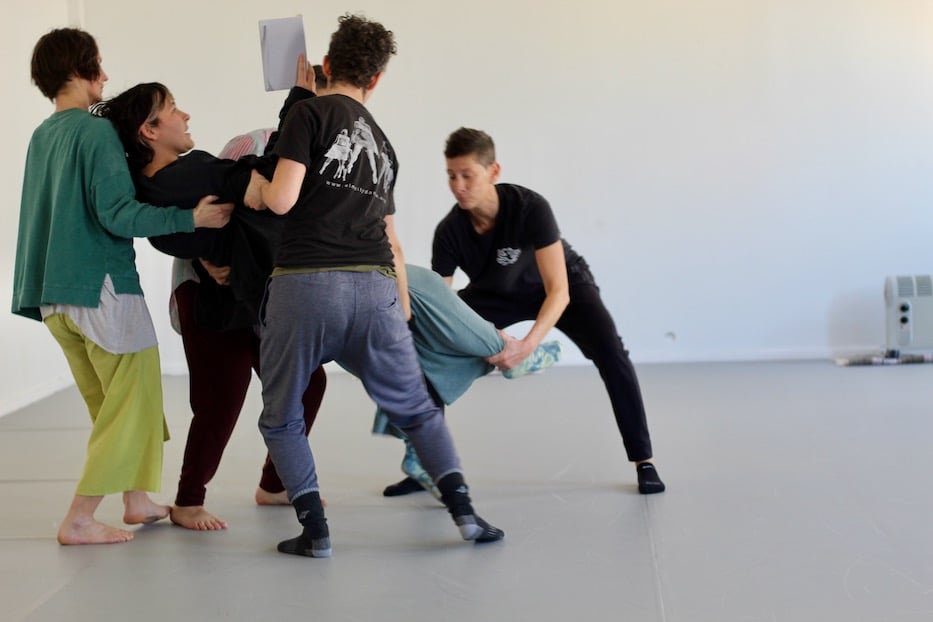
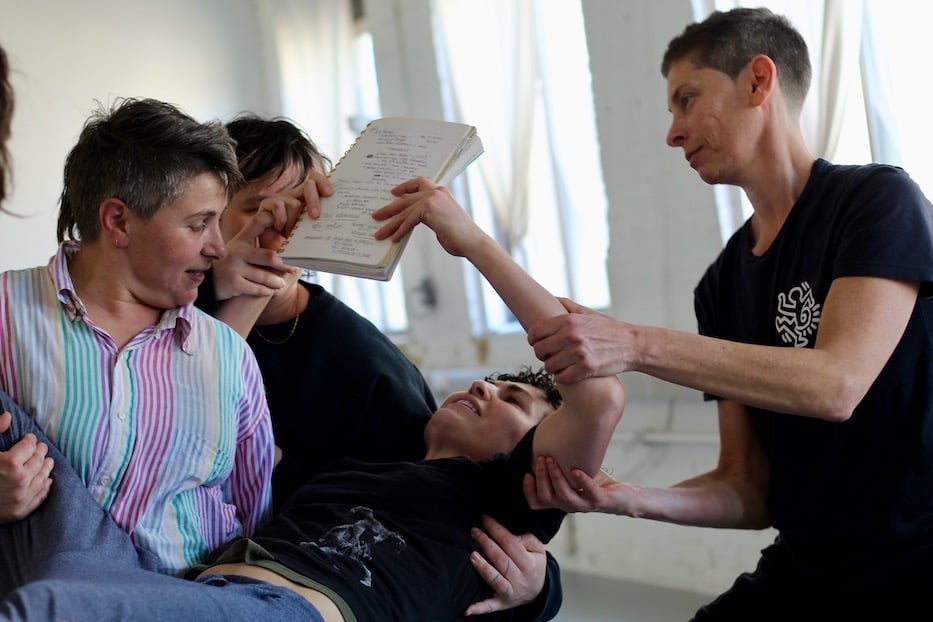
That momentum—and a sense that dancers are allowed and encouraged to play—carried through what may have been the most powerful exercise of the afternoon, as participants picked up their journals, and read from personal reflections on identity. As they did, fellow dancers swooped in, and physically supported them with commands of “move me”/”stop me.” Taking the floor first, Lee did a double take at the text after realizing they had left their reading glasses at home.
Then, they took a deep breath and dove in. Within moments, other participants had come in to carry them around the room as the words came.
“It reminds me of being 13, standing at the mirror—move me,” Lee sailed through the room, carried atop arms. One heel rested gently in Steinhauser’s cupped palm. “Trying to get a rise out of my hair, secretly closeting the wranglers my brother has outgrown—stop,” and the sound of four pairs of feet halted all at once. “Loving the way I feel and look wearing them—” they paused. “—I still can’t see, but I can tell you they make me look boxy and comfortable—”
Lee leaned back as a few laughs bubbled up from where attendees were sitting. Bauer held one shoulder; Lynch took the other. Weisman leaned to the far left, as if she was there as a secondary support if anyone got tired. Lee painted the image of their younger self, dressed in an oversized Looney Tunes shirt and totally at ease.
“You know the one, it was the 90s,” they said, and finished with a flourish of sudden applause.
“So you’re in control,” Lynch said to no one in particular. “Move me, stop. Move me, stop.”
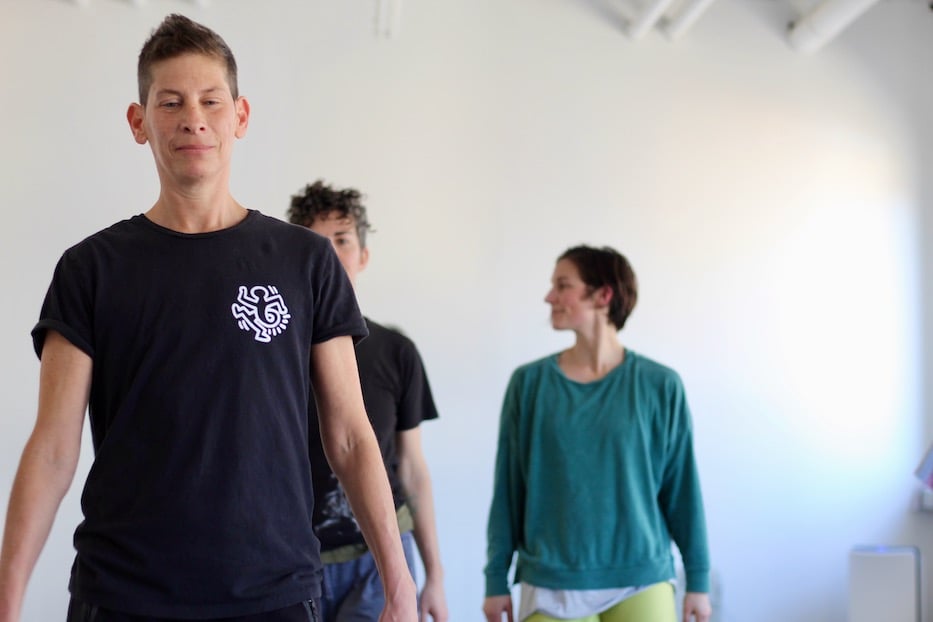
As if they had unlocked something, other participants prepared to read, one after the other. Weisman, who hesitated for only a moment before reading, picked up her journal and pointed to the way other women “clutch their pearls in worry” each time she enters a women’s restroom. With a tentative “Move me?” she was soon traveling through the space, recalling the number of times a new acquaintance has expected to hear a deeper voice.
When she cried “Stop! Just! Stop!” dancers stopped in their tracks.
Each participant brought something new to the space. For Bauer, who let herself turn floppy as she read, it was the revelation that it is still strange to be called “lady” and “mother,” because the terms don’t completely fit. For Steinhauser, it was the sense of “wanting to be everywhere”—a sensation that felt more possible as dancers helped them move their body from one end of the room to the other.
“I wonder which timeline I will finish or rest. I wonder if I will ever be able to pick one,” they read, breathing hard.
In a talkback afterward, all five said that they were grateful for the space, and for each other. For Lee, who has danced with ECDC on and off for the better part of a decade, it has become a ritual and a celebration of their body and their gender identity, exactly as they are.
“I can trust that I will arrive into this space and I can just be me,” they said. “I don't have to, like, wear so many veils. I can just be. And I know people will hold me.”
It could not come at a more critical time. Anti-trans legislation, particularly that which targets safe and gender-affirming care for young people, has made America an increasingly unsafe place for trans and nonbinary people. Currently, there are close to 400 anti-LGBTQ+ bills across 44 states, including over 150 pieces of legislation that target transgender and nonbinary people.
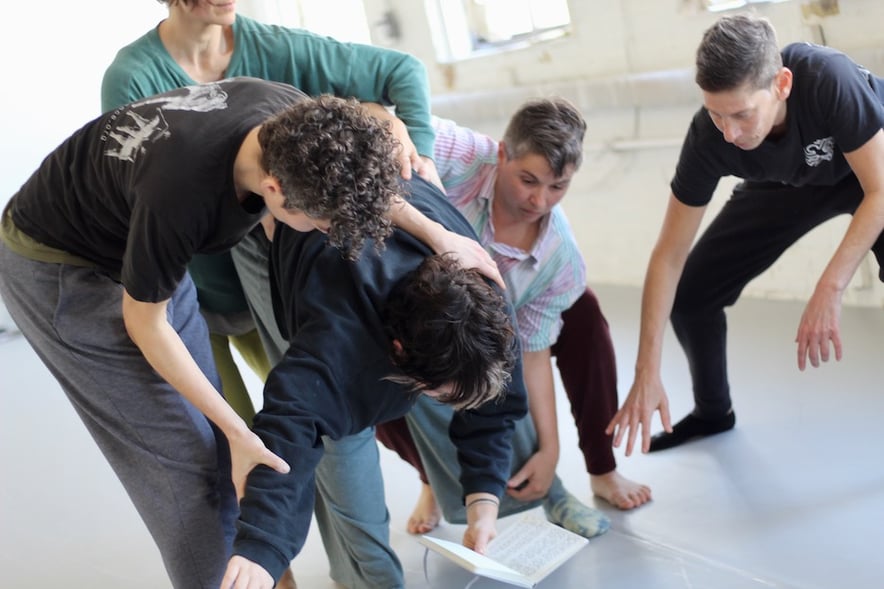
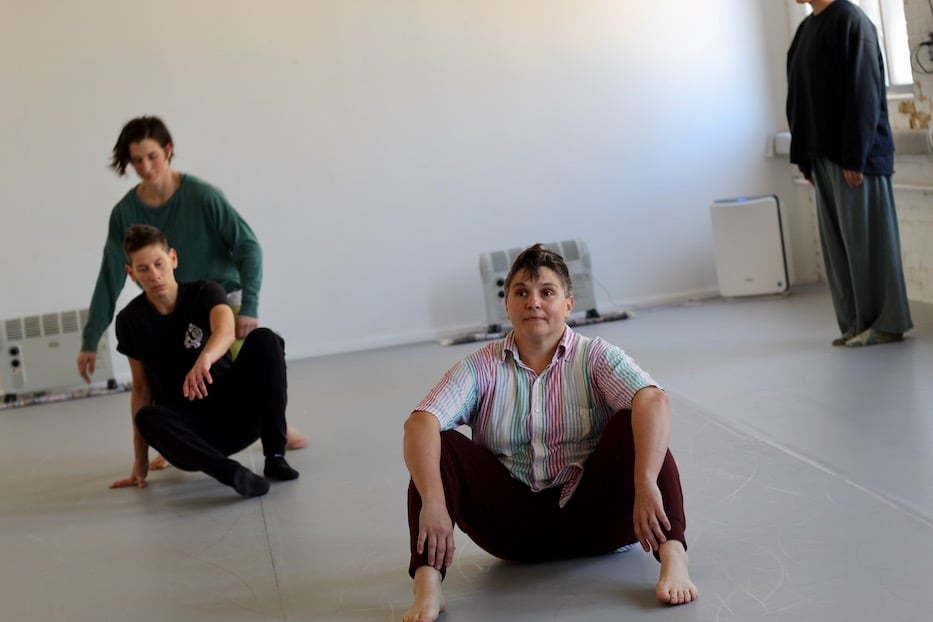
They range from bathroom bans to barring the use of hormone replacement therapy and hormone blockers to new restrictions for trans women and girls in sports. Nine state legislatures, all led by Republicans, have introduced legislation aimed at drag queens; over a dozen are trying to ban drag queen story hour. Joy, in the face of it, is a revolution, one improvised step at a time.
“I wanted to be in a vulnerable space and push myself,” said Weisman, a first-time participant who heard about the project through Bauer, and used both “she” and “free” pronouns to identify herself Sunday. “It felt very welcoming, and giggly at times. Joyful, and safe, which is what we want.”
Steinhauser, who is based in New Haven, added their appreciation to that chorus. The week leading up to Sunday was a difficult one, they said. At the beginning of the open studio, they sat to the side, stretching at their own pace. By the end of it, they were immersed in a dance that participants had drafted together, constantly in motion. House music thrummed beneath them.
“Showing up here and letting go and being in the space and being touched is a lot,” they said. “Not in a bad way—but it's very intensive for a bunch of people to show up and support you and love you and care for you and see you and to be creative and vulnerable.”
“It’s just a powerful thing to be flown around the room by the group,” they added, reflecting on the “move me” exercise. “You’re going and you’re flying but it doesn’t feel scary.”
Learn more about Elm City Dance Collective (ECDC) at their website.

